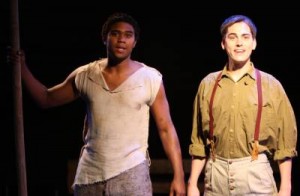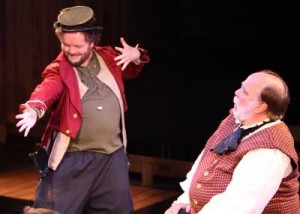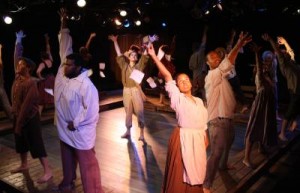
Actors Co-op + Richard Israel + Big River = Theater Magic.
What else would you expect from the merging of one of L.A.’s premier theater companies, StageSceneLA’s Musical/Comedy Director Of The Year, and the 1005-performance Tony-winning Best Musical of 1985?
Big River: The Adventures of Huckleberry Finn is, of course, adapted from Mark Twain’s classic 1884 novel of the same name (minus the Big River). Though Tom Sawyer returns as a major featured character, the storyline this time belongs to Huck, or better put, to Huck and escaped slave Jim, who travel the Mississippi in hopes of a new life for Huck and freedom for his companion in adventure. With book by William Hauptman and music and lyrics by the late, great country music superstar Roger “King Of The Road” Miller, Big River has brought bluegrass and country to Broadway, the rest of the U.S., the world, and now to Hollywood.
As any L.A. theater aficionado knows, our local companies have become experts at downscaling BIG BROADWAY MUSICALS to 99-seat-and-under stages, and no troupe has a better track record at doing this than the Co-op. For Big River, their smaller, black-box theater goes in-the-round for perhaps the first time—to sensational effect. Working with StageSceneLA’s Set Designer Of The Year Stephen Gifford, director Israel places the audience smack dab in the middle of the Mississippi with Huck and Tom’s raft just feet away from even the farthest onlooker.
It’s not just the set and seats that are in-the-round. From the show’s stunning opening number, “Do You Want To Go To Heaven?” Israel’s direction and Julie Hall’s lively choreography play to all four sides of the house, Huck’s adoptive family, his fishing buddies, assorted townspeople, and even local slaves shaking their fingers at the ever rambunctious Huck, voted least likely to pass through those pearly gates.
Huck’s adoptive mother (aka the Widow Douglas) and her spinster sister Miss Watson are none too happy with their charge’s recurring shenanigans, the latest of which is to form a band of thieves with best friend Tom and the rest of “The Boys.” Frustrated with the constraints of his new life, Huck attempts a return to the home of his alcoholic Pap, drunker than ever and railing as always against the “Guv’ment.” Escape seems the only out for Huck, who fakes his own death by scattering pig’s blood around Pap’s shack. Hiding out on Jackson’s Island, Huck meets Jim, also on the run, though in Jim’s case the reasons are far more serious. He has made his escape to avoid being sold down the river. Together, Huck and Jim make plans to travel the Mississippi as far as Ohio, which they hope will be the first stop on their path to freedom. The mismatched pair’s adventures have just begun.
Sean Hankinson makes a memorable Co-op debut here as Huck, easily winning the audience over with his all-American good looks and aw-shucks charm. Though occasionally tripping over lines (virtually never leaving the stage, he’s got a multitude of them to master), Hankinson radiates charisma, sings Miller’s songs, like the gospel-inspired “Waitin’ For The Light To Shine,” to perfection, and invests the role with real heart.
Opposite Hankinson, Israel has cast the superb James Fowler as Jim. Barely into his twenties, Fowler is a much younger Jim than usual, but the casting works. No longer a father figure to Huck, this Jim could easily be Huck’s slightly older brother, and when the two sing “Worlds Apart,” the song’s ironies are heightened by the fact that in every way other than race, the two could be mirror reflections. Instead, we have master and servant, free man and slave, and a lead character who uses the “N” word so casually that it shocks 21st Century ears. Fowler brings a profound dignity to Jim that belies his young years, and sings in as gorgeous a baritone as the role has ever been sung, particularly the rafters-raising spiritual “Free At Last.”
Big River is filled with a couple dozen great supporting and cameo roles, many of whom get their own solo or showcase number. Pamela Hamill and Tracy Ray Reynolds are a self-righteous hoot as Miss Watson and the Widow Douglas, joining voices and shaking fingers to “Do You Wanna Go To Heaven?” Bryce Blue brings Twain’s iconic Tom Sawyer to boyish, boisterous life, selling “The Boys” and “Hand For The Hog” with the showmanship of a pro. Curt Bonnem plays Man With Gun, Harvey Wilkes, and Silas Phelps in a variety of facial-hairstyles, but it’s as Huck’s drunk and delirious mess of a Pap, ranting against the dad gum “Guv’ment,” that Bonnem gets his rousing, well-deserved round of applause. Kyle Shepard likewise undertakes multiple roles, including Jo Harper and Lafe, but it’s his scene-stealing Young Fool that gets to sing the infectious “Arkansas.” As Alice’s Sister, Florida’s Anna Hulsey raises her gorgeous voice to heaven in “How Blest We Are.” Rory Patterson is a charming Mary Jane Wilkes, lending her own lovely soprano to “You Oughta Be Here With Me” (sung with Liz Randall and Cari Satre) and “Leavin’s Not The Only Way To Go” (with Hankinson and Blue). In addition to Hulsey, DeSean Anderson, Miles Jeffries, and Kellen Law do fine, touching work as slaves, joining voices on the powerful “The Crossing.” Excellent in multiple roles each are Brian Byers, Joshua Kuehl, Randall, Satre, and Landen Starkman.
Finally, there’s Big River’s answer to Stan Laurel and Oliver Hardy, the divine duo of Stephen Reynolds and Bruce Green as the supposedly long lost heirs to the French Throne and the Duchy of Bridgewater, probably the oddest mismatched pair of rapscallions ever to grace a Broadway (or Hollywood) stage. Mountainous Reynolds (The King) and pixyish Green (The Duke) steal scenes right and left, and rightfully so, with their colorful antics, larger than life personalities, and stellar vocal performances, including the rousing Act One closing number, “When The Sun Goes Down In The South.” Their rendition of “The Nonesuch” (“She’s got one big breast in the middle of her chest and an eye in the middle of her nose. So says I, if you look her in the eye, you’re better off looking up her nose.”) is riotously entertaining and the sight of Reynolds in Nonesuch garb is truly something to behold.
Director Israel brings the same imaginative flair to Big River that has made Anita Bryant Died For Your Sins, as well as Big The Musical and Violet, highlights of the past year. Working in-the-round, Israel makes sure that every performance plays to all four sides of the house. (There is literally not a bad seat in the Crossley black box.) Once again teamed with award-winning Gifford, the director and scenic designer have come up with an in-the-round set that surrounds the audience with sky and stars and makes Huck and Jim’s river raft appear seemingly out of nowhere and then spin its way down the Mississippi.
Insuring that the cast does full justice to songwriter Miller’s memorable score is the Co-op’s supremely talented Linda Kern, serving here as musical director, conducting the fine bluegrass band which provides perfect accompaniment to the cast’s harmonizing.
Lisa D. Katz’s lighting is exquisite, as are Vicki Conrad’s great period costumes. Rebecca Kessin’s sound design effectively mixes voices and musical instruments, with appropriate nocturnal sounds peppering Huck and Jim’s nights on the river.
Finally there is the sheer emotional impact of seeing a show about slavery in a United States being led by an African American President. Huck Finn starts his Big River ride not terribly comfortable with Abolitionism and ends his journey with eyes newly opened to the dignity of his fellow man. Though America still has a ways to go, Big River proves that we have come a long, long way.
Any Richard Israel production inevitably gets the town buzzing, and Big River is bound to be no exception—a show sure to play as well to the Co-op’s Christian subscriber base as it will to musical theater fans of every persuasion. It’s all-around brilliant work that theater lovers will not want to miss.
Actors Co-op, 1760 N. Gower St., Hollywood.
www.actorsco-op.org
–Steven Stanley
September 27, 2009
Photos: Lindsay Schnebly





 Since 2007, Steven Stanley's StageSceneLA.com has spotlighted the best in Southern California theater via reviews, interviews, and its annual StageSceneLA Scenies.
Since 2007, Steven Stanley's StageSceneLA.com has spotlighted the best in Southern California theater via reviews, interviews, and its annual StageSceneLA Scenies.







 COPYRIGHT 2024 STEVEN STANLEY :: DESIGN BY
COPYRIGHT 2024 STEVEN STANLEY :: DESIGN BY